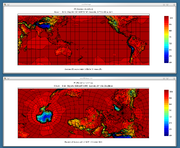GEM/4.6/Output Options for YIN-YANG Grid
| ||||||||||||||||||||||||||||||||||||||||||||||||||||||||||||||
The YIN-YANG grid may be output in 3 differente ways as shown on figure 1 to 3.


1 How to get the YIN-YANG output on the U grid (figure 1)
There are two ways to get the YIN-YANG output on the U grid (figure 1).
a) Set the gem_settings.nml key Out3_uencode_L = .true. (it is set to .false. by default). Note that this is the only way to get a U grid in interactive mode.
b) In batch mode, put the line
UM_EXEC_yy2e=1
in the configexp.cfg file. No matther what the Out3_uencode_L is set to, the output grid will be the U grid (figure 1). In the file transfert script, a program will be called to put the two records together if needed.
2 How to get the YIN-YANG output on 2 seperate native Z grids (figure 2)
Set the gem_settings.nml key Out3_uencode_L = .false. (which is the default). Make sure to have the line
UM_EXEC_yy2e=0
in the configexp.cfg file. Two sets of output files will appear in the output directory under subdirectories YIN and YAN.
3 How to get the the YIN-YANG interpolated on one Z grid covering the globe
Note that the data on the native YIN grid match exactly whith the data on the coresponding points of the interpolated Z grid. However, the data on the native YAN grid will not match since it is interpolated.
- Set the gem_settings.nml key Out3_uencode_L = .false. (this is the default)
Make sure to have the line
UM_EXEC_yy2e=2
in the configexp.cfg file.
| ||||||||||||||
